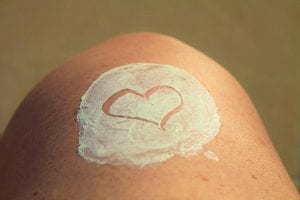Summer Sunscreen Facts
 For pale faces like me, sunscreen is an absolute necessity. I would not be able to enjoy my outdoor lifestyle without serious protection for my skin. Recent research found that some ingredients from sun protection products are being absorbed into your body.
For pale faces like me, sunscreen is an absolute necessity. I would not be able to enjoy my outdoor lifestyle without serious protection for my skin. Recent research found that some ingredients from sun protection products are being absorbed into your body.
Is this a risk to your health?
Researchers say these sunscreen ingredients– avobenzone, oxybenzone, octocrylene and ecamsule – are present in the blood after sunscreen application at levels that would, under current Food and Drug Administration (FDA) guidelines, trigger a requirement for further safety testing. Unfortunately, sunscreen has not been reviewed by the FDA since the 70s nor have they approved any new ingredients since the 90s. That means all of the new information we have about sunscreen, its effectiveness, and the prevention of sunburn and cancer, is extremely outdated. It also means we don’t really know if absorbing sunscreen chemicals is harmful to our health.
Let’s look at a few facts about sunscreen.
Only two chemicals used in sunscreen currently meet the FDA’s standard of “generally recognized as safe and effective” (GRASE): titanium dioxide and zinc oxide. The FDA has requested that manufacturers submit information on the safety and effectiveness of 12 other ingredients to determine if they are GRASE. Those include oxybenzone, ensulizole, octisalate, octocrylene, octinoxate, avobenzone and cinoxate, dioxybenzone, meradimate, and sulisobenzone.
European sunscreens provide better UVA protection. Nearly every sunscreen sold in the U.S. claims to offer protection against harmful UVA rays. UVA rays play a role in skin cancer formation as they penetrate more deeply into the skin and play a greater role in premature skin aging.
Most products sold in the U.S. are too weak to be sold in Europe, Japan, Australia or Canada, where standards are higher. In Europe, sunscreen makers can formulate their products with four chemicals that offer stronger protection from UVA rays. American manufacturers and consumers are awaiting FDA approval to use these sunscreen ingredients. Until the FDA approves them and lifts restrictions on combining certain active ingredients, Americans will not be able to buy sunscreens with the strongest UVA protection.
Some harmful ingredients in your sunscreen may expose you to other health risks. Several commonly used ingredients in sunscreen appear to block or mimic hormones, and others cause allergic reactions on sensitive skin. The FDA’s sunscreen rules ‘grandfathered in’ active ingredients that were already on the market, meaning these chemicals are still added to some products.
In February of this year, the FDA announced a proposed rule that would update regulatory requirements for sunscreen. The proposal includes, among other things,
- a recognition of two ingredients – zinc oxide and titanium dioxide – are GRASE for use in sunscreens; two ingredients – PABA and trolamine salicylate – are not GRASE for use in sunscreens due to safety issues.
- Proposes to raise the maximum proposed SPF value on sunscreen labels from SPF 50+ to SPF 60+.
- Proposes that products that combine sunscreens with insect repellents are not GRASE.
If you are serious about sun protection, here are some tips for staying healthy and enjoying better, more effective protection.
If you avoid the sun, take a vitamin D supplement. Sun exposure is the best way to absorb vitamin D. Not getting any sun? A vitamin D3 supplement is the best way to get your fix with limited or no sun exposure.
Use sunscreens with the best ingredients for maximum protection. Mineral sunscreens made from titanium dioxide and zinc oxide are the most effective. Mineral-based products sit on our skin and reflect sunlight, while chemical sunscreens use synthetic chemicals to absorb the sun’s rays only after they’ve penetrated the skin. For more information about good sunscreen choices, check out this article on Healthline.
Read labels! Right now, it is easy to pick up a sunscreen without understanding what it will actually do to prevent sun damage. Be sure to look for a product with at least 15 SPF for UVB protection, UVA protection (broad spectrum), water and sweat resistance, and sensitive skin formula if you have allergies, sensitivities, or skin conditions such as rosacea.








